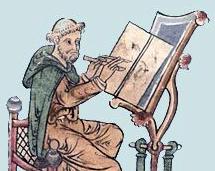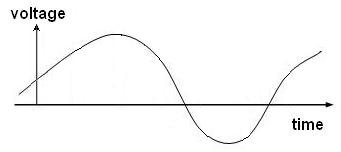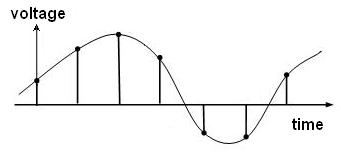
I'm talking about making a copy of an already existing document. There were many ways of making multiple copies of a document when it was first generated - after all, the printing press goes back to Gutenberg. On a smaller scale, carbon paper allowed us to create three or four copies of a document at a time. Note 2 To generate a larger number of copies of a document, one could cut a mimeograph stencil, or a spirit duplicator stencil. But given a single copy of a document produced earlier, we had no easy way to reproduce it. Note 3 This was just the continuation of a problem that had existed since the start of human history. All physical media, such as paper, eventually decay. If the information written on the medium is to be preserved, it must be copied before the medium crumbles. This was even worse before the days of media such as "acid-free paper", which can last 100 years. Older media lasted for much less time. So in order to preserve them, documents that were considered important had to be copied and recopied and recopied. We have no original copies of any of the books of the Bible, for example (by "original", I mean written down by the original authors). All we have are copies. And they are not even first-generation copies, so they are copies of copies of copies. Anytime something is copied in this way, errors are bound to be introduced. In the early days of Christianity, errors in the New Testament books were introduced at a very rapid rate, because the books were copied by amateur copyists. Later, when the copying was taken over by the church, the copyists got more professional, and the error rate dropped. But the fact is, we can't know precisely what the original authors wrote. Note 4 Although the process of xerography was first developed in 1937, it was many years before a truly practical office copier was produced and sold. By the time I went off to college in 1959, these were beginning to appear, but they were very large and expensive machines. Hence they were generally leased, rather than purchased, by their users. Where copiers were available, they tended to be tightly controlled by their owners, so that the per copy expense didn't get out of hand. At that early stage, the idea that we might one day have home copiers seemed inconceivable. But over the following decades, the price of copiers declined, until even small home machines became quite cheap. Along the way, the quality of the copies improved as well, although until recently, copiers still used analog technology. Note 5 Since as you probably know, I'm interested in languages, let me briefly mention a change that copiers brought to English. It's common in English to convert nouns into verbs whenever it's helpful. For example, we can say things like "The team was bused to the game", instead of the more awkward "The team was taken to the game by bus." But I was startled one day (many years ago) to hear someone, looking at a memo in a coworker's hand, utter the words "Copy me on that". What he meant was, "Send me a copy of that memo." The reason I was surprised to hear "copy me" used in that way was because the words "copy me" already had a different meaning: they meant "Do as I do." Nevertheless, the use of the verb "copy" to mean "send a copy to" has become quite commonplace, and its meaning is generally obvious in context. I'd now like to talk about another form of copying: digital copying. I've already alluded to this in my introductory entry, "Why write using the HTML and JPG file formats?". In that entry, I said,
Sent out over the Internet, it may pass through numerous data communications links and computers en route to its final destination. Each time, it's copied into an input buffer, probably transferred to a disk drive momentarily, eventually copied to an output buffer, then to a data communications buffer, and then sent on its way to the next intermediate Internet node. Upon arriving at its final destination, it's again copied multiple times before finally appearing on the screen of whatever program the receiver is using as a mail reader. Exactly what happens depends on what software and what operating system are being used. But I wouldn't be surprised to find that your text is copied and re-copied hundreds of times while in transit to its final destination. The operation of the Internet absolutely depends on the ability to copy digital files with no errors whatsoever. Indeed, everything we do in the digital environment depends upon this ability to make flawless copies: our computers, data communications systems such as the internet, digital music players such as the iPod, music CDs, high-quality long-distance telephony, digital video recorders, voice messaging systems, and so on. None of these would be possible with analog technology, in which each copy is a degraded version of the original. Copying, in all its forms, has come a long way since the dark ages. Just how can digital technology make perfect copies. Read on if you want a very simple explanation. Or, if you don't care (or already know), click the next link to jump to the footer to decide where to go next. Let's use music as an example.
Such a signal can be transmitted or stored in analog form, for example in an old-style AM or FM radio signal, or on an old-fashioned audio cassette tape. But whenever it is thus transmitted, or stored and recovered from storage, errors (called "noise") are bound to be introduced. This is unavoidable, so if multiple generations of copies are made, the signal can become quite degraded.
Once this has been done, all further handling of the signal will be done using these numbers. Note 6 Now, how can we transmit (or store and recover) these numbers? First of all, in computer circuitry, these are not ordinary decimal numbers of the sort we use in our everyday life, made up with the digits zero through nine. Rather, these are numbers in the binary system (base two) that is used by computers. Binary digits (called "bits") can only take on two values, zero or one. Thus the binary numbers can be transmitted (or stored) by an electrical signal which takes on only one of two values at specified points. For example, the signal might take on a value of zero volts to represent a binary zero, and five volts to represent a binary one. When the signal is received (or read back from the storage device), an electronic circuit looks at the voltage obtained. If no noise has been introduced in the transmission (or storage/recovery process), then the signal at all significant points should be either 0 volts or 5 volts. But if noise has been introduced, the signal might vary slightly from these values. However, since we know that the signal was originally either zero or 5 volts, it's pretty easy for the receiving circuit to decide what the original value must have been. For example, if the signal is 4.3 volts or 5.2 volts, then it's a pretty sure bet that it was intended to be a 5 volt signal, namely a binary "one". In other words, the fact that the signal is only allowed to take on two widely separated values makes it easy to correct any errors that might have been introduced in the transmission (or storage/recovery). And that's how digital transmission (or storage) can make copies of the signal without introducing errors. Each time a "copy" is made, the signal can be reconstructed, good as new. There are actually other, less obvious, advantages to storing the signal in digital (numerical) form. Once you are transmitting (or storing) numbers, you can use various mathematical tricks to determine if any errors have been made, and in fact even to correct those errors. For simplicity, I won't go into these techniques here. But there's a whole field of coding theory, which allows engineers to design systems in which the possibility of an undetected error has been reduced to below any desired tiny probability. Once the signal has been correctly received (or read from the storage device), it can be converted back to an analog electrical signal by a digital-to-analog converter ("D/A converter"), and fed into a loudspeaker or set of headphones to be turned back into sound.
  Note 1: I'm sure I sound like an old fogy here: "In my day, we had to walk to school through three feet of snow, uphill both ways." A friend, Kim Reichelt (editor of the WaylandeNews), recently posted on Facebook that "I loved several of my son's comments last night as we watched the 1980 film 'My Bodyguard' together as a family. My favorite: when one character couldn't find the part he needed to repair his motorcycle, my son asked, 'Why doesn't he just look on eBay?'." Kim's husband Mark commented, "I loved his 'Wow, I didn't realize they didn't have Internet in 1980'." I'm writing this entry partly because I think many young people don't realize that our ability to make copies is relatively recent. [return to text] Note 2: Carbon paper was a thin sheet of paper with a soft black coating on the back side. When placed between two sheets of paper, typing or writing on the top sheet would transfer an identical image to the second sheet of paper. Actually, you could generally make up to two or three of these "carbon copies". Most young people these days know this only from the "cc" field in e-mail addresses - this originally stood for "carbon copy". When you sent a letter to someone, and a carbon copy to, say "Joe Smith", it was customary to note at the bottom of the letter, "cc: Joe Smith", to notify the recipient that Joe had received a copy. You might also send Joe a "blind carbon copy". In this case, you would separate Joe's carbon copy, and type on the bottom "bcc: Joe Smith". That way Joe would be informed that the original recipient of the letter did not know that Joe had gotten a copy. [return to text] Note 3: Some of you might be now asking, "What was a spirit duplicator?" (in the US, it was also called a "Ditto" machine). A spirit duplicator master comprised two sheets, attached at the top. The front sheet had a shiny back surface, and the second sheet was coated with a wax-based solid ink, on the side facing the front sheet (sort of like carbon paper in reverse). When you typed (or wrote) on the front sheet, the impact of the typewriter (or the pressure of the pen) transferred some of the ink to its shiny surface, in a mirror image. When the stencil was completed, the back sheet supplying the ink was torn off and discarded. The stencil was then wrapped around a drum, in a machine (generally hand cranked) which infused alcohol into sheets of paper, and pressed them against the stencil as the drum rotated. This transferred a tiny bit of the ink on the stencil to each page. Since eventually the ink would be used up, a stencil was only good for a hundred copies or so (masters of the art could get many more copies by typing with great force when making the stencil (transferring more ink), and gradually increasing the pressure during printing as the impressions started to get faint. The alcohol mix used to soften the waxy ink was highly volatile. I recall being told a story at MIT about a couple of students working in a copy center there. Some idiot (yes, there are idiots even at MIT) walked into the room with a lit cigarette, and the cloud of alcohol around the machine burst into flame. One of the students started screaming, and the other student's shirt actually seemed to catch fire. Someone listening with me to this tale commented at this point in the story, "So now you had one screaming asshole and one flaming asshole. What happened next?" Actually, what happened next is that the flames quickly went out, and nobody was hurt. Although highly volatile, the cloud of alcohol vapor did not provide enough fuel to sustain the flames for very long. [return to text] Note 4: For more on textual variants in the Gospel accounts, see the book Misquoting Jesus, by Bart D. Ehrman [return to text] Note 5: In the early days of office copiers (and even in the not so early days), paper jams were a major problem. It was hard to get through any sizable copying job without a jam or two. Users (myself included) became expert at opening up all the points in the machine along the paper path, and pulling out the pages that had gotten snagged. I attributed this problem to the fact that paper is a poorly controlled product, both dimensionally, and with respect to its moisture content. Paper can also get dirty with handling, sometimes picking up oils from a user's fingers, or sticky substances of one form or another. I figured that frequent paper jams would be with us as long as there were copiers. Except this didn't prove to be the case. I now have a Canon PC330 home copier that I bought at Staples in 1994 for $399.99, plus $79.99 for a toner cartridge. It feeds its paper nearly flawlessly. A year can go by between incidents in which it accidentally feeds two sheets instead of one (and the feed mechanism is nearly twelve years old). I don't know exactly how the designers solved this problem, but they obviously did it very well. It also helps that the paper path is a straight line and extremely short, and perhaps over the years the paper manufacturers have improved the quality of the paper itself. But my inexpensive home copier feeds paper easily ten times more reliably than the $100,000 copiers I used in the sixties and seventies. [return to text] Note 6: For those of you who are real gluttons for detail, I should note that the sampling process introduces two forms of error. First, the voltage level of the signal at the sampling point can only be measured to some degree of accuracy (that is, some number of significant figures). To the extent that the signal might differ slightly from the value measured, a type of error called "quantization error" has been introduced. This happens only once, though, when the signal is initially digitized, and the error can be kept as small as desired by sampling to a high degree of accuracy (that is, using longer numbers). No additional errors are introduced by making further copies. Also, the numbers only specify the value of the signal at the sampling points. What if the signal does something odd in between two samples? Actually, this proves to be less of a problem than quantization error. For real signals, the highest frequency contained within the signal is generally limited (that means there's an upper limit on how fast the signal can wiggle). For example, even a high-quality audio signal contains no frequencies above 20 kHz (20,000 cycles per second). Mathematically, it turns out that you need to sample your signal at twice the highest frequency the signal contains (this is known as the Nyquist rate), in the audio case 40,000 times per second. It's then mathematically possible to reconstruct the original signal perfectly. [return to text]
 |

 Sound is a pressure wave, traveling through the air. A microphone converts it into an electrical signal like the one shown to the left, whose voltage ("voltage" is a measure of electrical pressure) varies with time. This is called an "analog" signal, because the amplitude of the voltage is an "analog" of the amplitude of the sound pressure.
Sound is a pressure wave, traveling through the air. A microphone converts it into an electrical signal like the one shown to the left, whose voltage ("voltage" is a measure of electrical pressure) varies with time. This is called an "analog" signal, because the amplitude of the voltage is an "analog" of the amplitude of the sound pressure.
